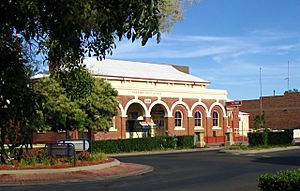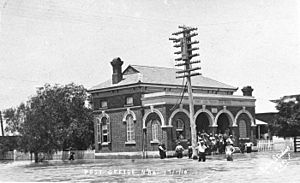Narrabri Post Office facts for kids
Quick facts for kids Narrabri Post Office |
|
|---|---|
 |
|
| Location | 138-140 Maitland Street, Narrabri, New South Wales, Australia |
| Built | 1888 |
| Architect | New South Wales Colonial Architect's Office under James Barnet |
| Official name: Narrabri Post Office and former Telegraph Office | |
| Type | Listed place (Historic) |
| Designated | 08 November 2011 |
| Reference no. | 105495 |
| Builders | FA King |
| Lua error in Module:Location_map at line 420: attempt to index field 'wikibase' (a nil value). | |
The Narrabri Post Office is a very old and important building in Narrabri, New South Wales, Australia. It's located at 138-140 Maitland Street. This building is special because it's on the Commonwealth Heritage List. This means it's protected for its history and design.
It was designed by the NSW Colonial Architect's Office under James Barnet. A builder named FA King finished building it in 1888. The building is also known as the Narrabri Post Office and former Telegraph Office.
Contents
The Story of Narrabri Post Office
The Narrabri area first saw farming activities in the 1830s. A small town started to grow in the late 1840s. By 1860, Narrabri was officially recognized as a town.
Early on, a post office and police station were set up. However, a big flood hit the town in 1864. This flood caused a lot of damage.
Later, in 1882, the railway arrived in the district. This brought more people to live and work in Narrabri.
The Narrabri Post Office building we see today was built in 1888. It was designed by the New South Wales Colonial Architect's office. James Barnet was in charge of the design. FA King was the builder.
In January 1910, the post office was flooded again. Around 1914, the building was made bigger. Two more arches were added to its front design. This made the building even grander.
What the Post Office Looks Like
The Narrabri Post Office is a single-story building. It is made of brick with a timber floor. The roof is made of corrugated iron.
The building sits on a corner where Maitland and Doyle Streets meet. This is in the main shopping area of Narrabri.
Main Features of the Building
The original design by James Barnet had four arches at the front. These arches were part of a verandah. Around 1914, two more arches were added. Now, this front area is enclosed. It holds the main public hall and the post office boxes.
The roof has a hipped and gabled shape. It is covered with corrugated iron. You can see several chimneys on the roof. These chimneys are made of brick.
The front of the building, facing Maitland Street, has a special design. It uses brick and stucco (a type of plaster). Above the arches, the name "Narrabri Post Office" is written. Each arch has a special stone at the top called a keystone.
There's a date plaque with "1888" on it between two of the arches. The windows inside the arches are sash windows. They have an arched shape at the top.
Changes Over Time
The side of the building facing Doyle Street is simpler. It has plain brick walls and rectangular windows.
Originally, the building also included living areas for the postmaster. These "quarters" were connected to the post office. Over the years, parts of the building were changed. For example, some verandah areas were enclosed.
A larger telephone exchange building was added later, probably in the late 1960s. This building looks different from the old post office. It has a modern design with smooth cream bricks. It is now separated from the post office by a fence.
The post office has been updated inside several times. This happened in the 1980s and again in 2002. These updates made it a modern Australia Post shop. Even with these changes, many original features, like the ceilings, have been kept.
Building Condition
The Narrabri Post Office is in good condition. The outside of the building still looks much like it was designed. Only small changes have been made, like adding signs and a ramp.
Inside, the main layout of the building is still the same. Any new walls for the shop area can be easily removed. This means the original design is still clear to see.
Building Timeline
- 1888: The post office was built.
- 1895: Some repairs were made.
- 1914: Additions were made, including two more arches at the front.
Why Narrabri Post Office is Special
The Narrabri Post Office is listed on the Australian Commonwealth Heritage List. This happened on November 8, 2011. It's important for several reasons:
- Its History: The post office, built in 1888, is a key building in Narrabri's main street. It shows how important Narrabri was in the late 1800s. It provided postal services for a growing region. The building's design, with its arches, was later extended.
- Its Design: The Narrabri Post Office is a great example of a post office from that time. It also shows the work of the famous Colonial Architect, James Barnet. He designed many important buildings. This post office is special because it shows Barnet's changing style. It was one of his first single-story post offices with an arcaded front. It also shows how he started to use concentric arches in his designs. The way the living quarters are placed next to the public area on the same floor is also unique for his designs.


